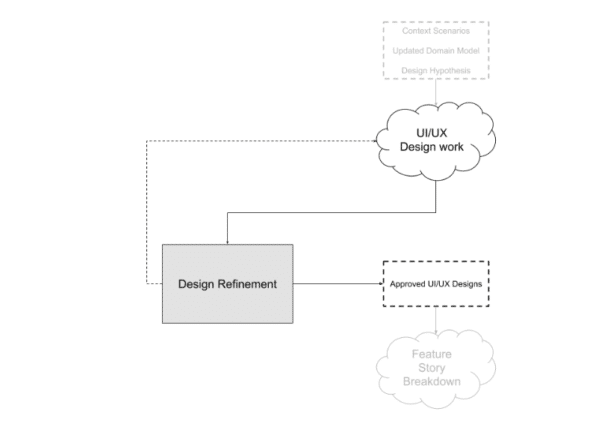In my last post, I described a process for keeping a large Agile team focused on getting work ready for developers. The process includes a few crucial check-in meetings: product backlog refinement, design refinement, and technical refinement. Because the check-ins are so few, it’s very important to keep that time focused on the work at hand.
One thing that’s helped our team stay focused during those meetings is a document I created called a Meeting Guide. For each product backlog refinement, design refinement, or technical refinement, I create a one-page document that I give to each attendee.
The Meeting Guide contains the same six sections: Inputs, Goals, Outputs, Questions to Ask Yourself, Try to Avoid, and Where Are We.
1. Inputs
The Inputs section lists the general tasks that have been completed prior to this meeting. For example, in our design refinement meeting, our inputs include:
- Refined context scenarios
- Up-to-date domain model
- Design hypothesis
This section provides context around the work the team has done leading up to the current discussion. It may remind team members about discussions and decisions that were made earlier, avoiding the common pitfall of rehashing decisions at every step.
2. Goals
The Goals section outlines the specific goals of the meeting. These goals are meant to guide the discussion, keeping it at the correct fidelity. If discussions begin to wander off-track, any team member can point to the Goals section to steer the discussion back to the correct topic.
Our Goals section for product backlog refinement includes:
- Refine context scenarios
- Discuss domain model updates
- Refine design hypothesis
3. Outputs
The Outputs section defines the concrete deliverables we expect to come from the meeting. This section helps keep the team accountable for following up.
For example, if we are in a design refinement meeting where one of the goals is to give feedback on UI/UX design, one of the outputs is Updated UI/UX Wireframes. If we fail to deliver this output, the developers will be working with out-of-date wireframes, which will ultimately result in re-work and confusion.
4. Questions to Ask Yourself
This is my favorite section of the Meeting Guide; it provides some prompts to get attendees in the right frame of thought.
One of our questions for technical refinement is, “Do I have the definition I need to complete the work?” This question helps developers focus on the requirements provided in the story. Also, it helps them think about other potential dependencies of this work.
Here’s another question listed in our product backlog refinement Meeting Guide: “Is the context scenario core to our next milestone?” This question is great for getting team members to focus on the work that’s needed to achieve our next milestone instead of wasting time discussing things that aren’t top priorities.
5. Try to Avoid
The Try to Avoid section helps prevent some of the traps teams can encounter. For example, in product backlog refinement, we try to avoid discussing technical details. This keeps the team focused on discussing the business value provided by particular features, instead of how we will actually implement the feature.
In design refinement, we try to avoid design by committee. This keeps the team on the track to give specific feedback, while letting the experts (the designers) use that feedback to improve the user experience.
6. Where Are We?
This section is a visual snippet of the Agile Pipeline visual, which includes the work that was done prior to the meeting and the outputs of the meeting.
Our design refinement Where Are We? visual looks like this:

The Meeting Guide has been a great tool for our big team. It has helped us focus on the right things at the right time. It’s allowed us to create accountability in meetings, and it provides a framework for getting work through the process.
Check out our current guides for product backlog refinement, design refinement, and technical refinement.

